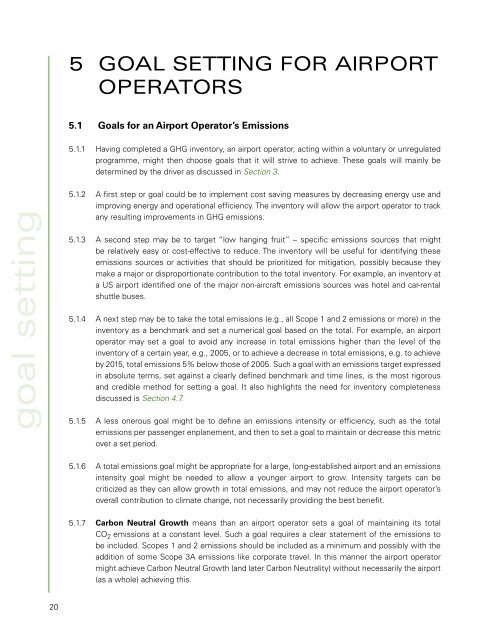Airport Greenhouse Gas Emissions Management - Zurich Airport
Airport Greenhouse Gas Emissions Management - Zurich Airport
Airport Greenhouse Gas Emissions Management - Zurich Airport
Create successful ePaper yourself
Turn your PDF publications into a flip-book with our unique Google optimized e-Paper software.
5 GOAL SETTING FOR AIRPORT<br />
OPERATORS<br />
5.1 Goals for an <strong>Airport</strong> Operator’s <strong>Emissions</strong><br />
5.1.1 Having completed a GHG inventory, an airport operator, acting within a voluntary or unregulated<br />
programme, might then choose goals that it will strive to achieve. These goals will mainly be<br />
determined by the driver as discussed in Section 3.<br />
goal setting<br />
5.1.2 A first step or goal could be to implement cost saving measures by decreasing energy use and<br />
improving energy and operational efficiency. The inventory will allow the airport operator to track<br />
any resulting improvements in GHG emissions.<br />
5.1.3 A second step may be to target “low hanging fruit” – specific emissions sources that might<br />
be relatively easy or cost-effective to reduce. The inventory will be useful for identifying these<br />
emissions sources or activities that should be prioritized for mitigation, possibly because they<br />
make a major or disproportionate contribution to the total inventory. For example, an inventory at<br />
a US airport identified one of the major non-aircraft emissions sources was hotel and car-rental<br />
shuttle buses.<br />
5.1.4 A next step may be to take the total emissions (e.g., all Scope 1 and 2 emissions or more) in the<br />
inventory as a benchmark and set a numerical goal based on the total. For example, an airport<br />
operator may set a goal to avoid any increase in total emissions higher than the level of the<br />
inventory of a certain year, e.g., 2005, or to achieve a decrease in total emissions, e.g. to achieve<br />
by 2015, total emissions 5% below those of 2005. Such a goal with an emissions target expressed<br />
in absolute terms, set against a clearly defined benchmark and time lines, is the most rigorous<br />
and credible method for setting a goal. It also highlights the need for inventory completeness<br />
discussed is Section 4.7.<br />
5.1.5 A less onerous goal might be to define an emissions intensity or efficiency, such as the total<br />
emissions per passenger enplanement, and then to set a goal to maintain or decrease this metric<br />
over a set period.<br />
5.1.6 A total emissions goal might be appropriate for a large, long-established airport and an emissions<br />
intensity goal might be needed to allow a younger airport to grow. Intensity targets can be<br />
criticized as they can allow growth in total emissions, and may not reduce the airport operator’s<br />
overall contribution to climate change, not necessarily providing the best benefit.<br />
5.1.7 Carbon Neutral Growth means than an airport operator sets a goal of maintaining its total<br />
CO 2 emissions at a constant level. Such a goal requires a clear statement of the emissions to<br />
be included. Scopes 1 and 2 emissions should be included as a minimum and possibly with the<br />
addition of some Scope 3A emissions like corporate travel. In this manner the airport operator<br />
might achieve Carbon Neutral Growth (and later Carbon Neutrality) without necessarily the airport<br />
(as a whole) achieving this.<br />
20

















